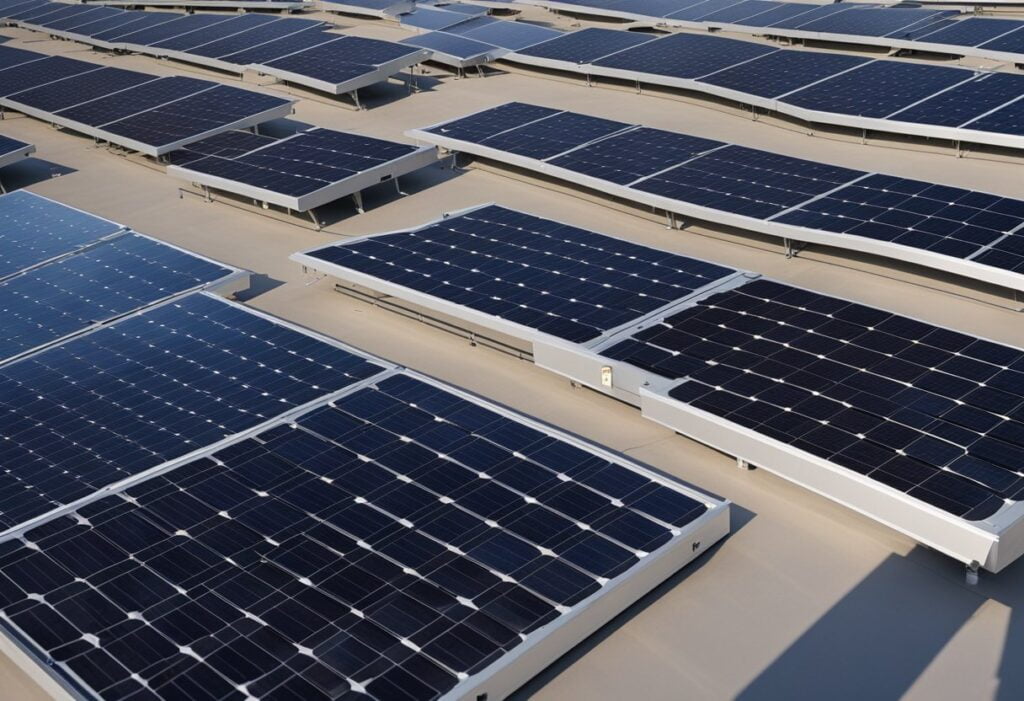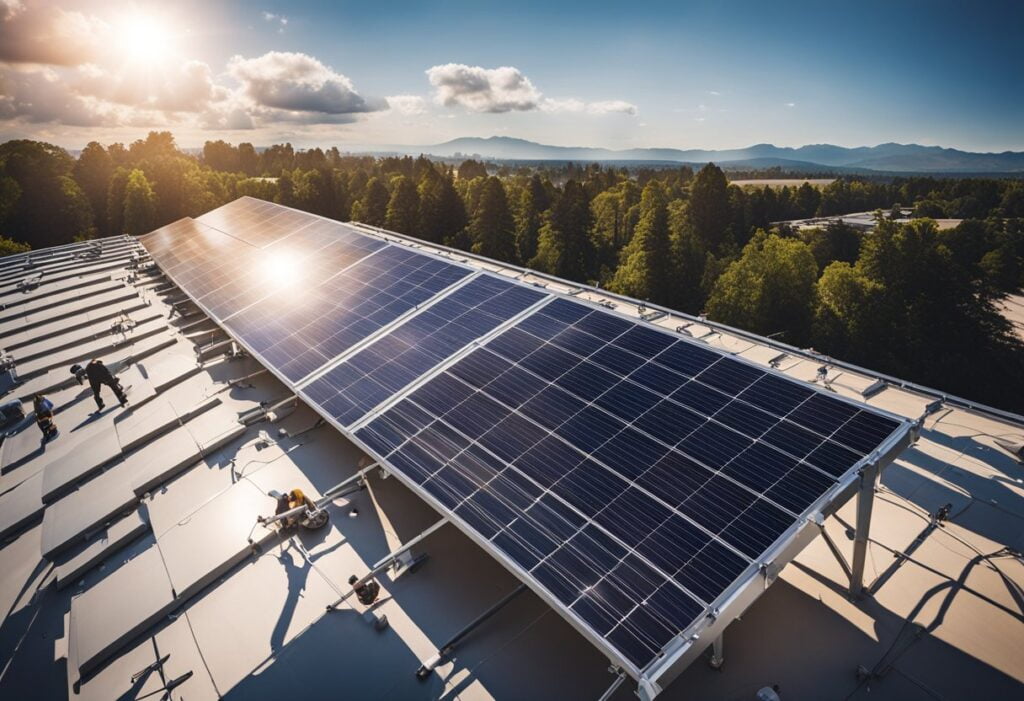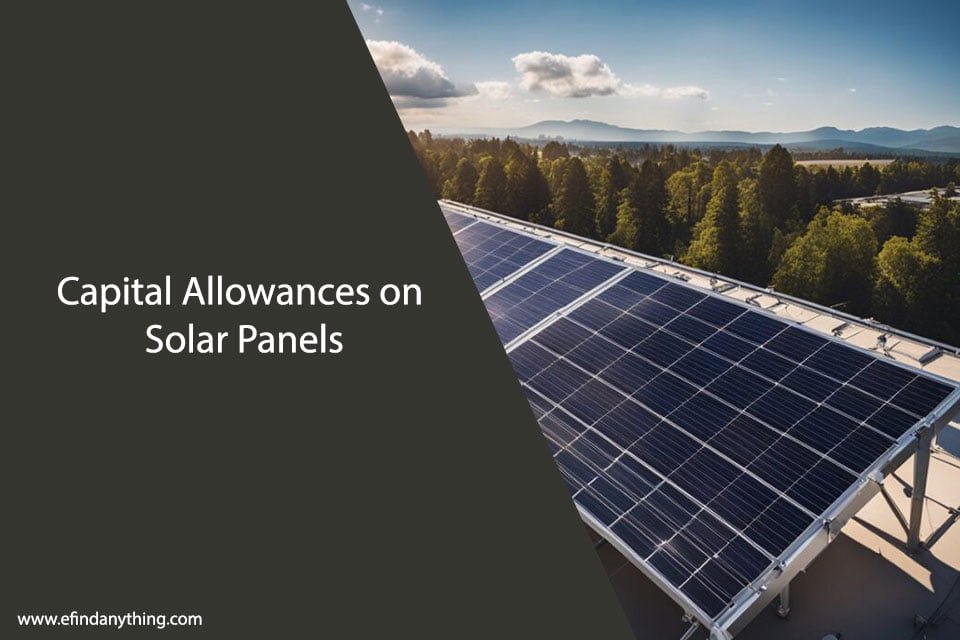Capital allowances on solar panels are a valuable incentive for businesses and individuals looking to invest in renewable energy. These allowances allow for the cost of solar panels to be deducted from taxable profits, providing a significant financial benefit. In this article, we will explore the details of capital allowances on solar panels and how they can be claimed.

The government’s commitment to reducing carbon emissions has led to a variety of initiatives and incentives designed to encourage the adoption of renewable energy. One such initiative is the capital allowances scheme, which allows businesses and individuals to claim tax relief on the cost of installing solar panels. This scheme can provide a substantial financial benefit, making solar energy an attractive option for those looking to reduce their carbon footprint and save money on energy bills.
The process of claiming capital allowances on solar panels can be complex, with various rules and regulations to navigate. However, with the right guidance and support, it is possible to take advantage of this valuable incentive. In the following sections, we will provide a detailed overview of the capital allowances scheme and the steps required to claim them.
Table of Contents
Understanding Capital Allowances
Definition and Purpose
Capital allowances are tax deductions that businesses can claim on certain types of assets, including solar panels. The purpose of capital allowances is to provide tax relief for businesses that invest in assets that are used for the purpose of generating income. By claiming capital allowances, businesses can reduce their taxable profits, which in turn reduces the amount of tax they have to pay.
Solar panels are a type of asset that is eligible for capital allowances. This means that businesses can claim tax relief on the cost of purchasing and installing solar panels. The amount of tax relief that can be claimed depends on a number of factors, including the cost of the solar panels, the size of the installation, and the type of business that is claiming the relief.
Eligibility Criteria for Solar Panels
In order to claim capital allowances on solar panels, businesses must meet certain eligibility criteria. Firstly, the solar panels must be used for the purpose of generating income. This means that they must be used to generate electricity that is sold to the grid, or used to power the business premises.
Secondly, the solar panels must be new and unused. This means that businesses cannot claim capital allowances on second-hand or refurbished solar panels.
Finally, businesses must ensure that the solar panels are installed in a way that meets certain technical requirements. This includes ensuring that the panels are installed by a qualified installer, and that they are connected to the grid in a way that meets all relevant safety and technical standards.
In conclusion, understanding capital allowances on solar panels is an important consideration for businesses that are looking to invest in renewable energy. By claiming capital allowances, businesses can reduce their tax liability and support the transition to a low-carbon economy.
Types of Capital Allowances on Solar Panels
When it comes to capital allowances on solar panels, there are three main types that businesses can claim. These are First Year Allowances (FYAs), Writing Down Allowances (WDAs), and Annual Investment Allowance (AIA). Each of these types of capital allowances has its own rules and rates, so it’s important to understand how they work before making a claim.
First Year Allowances
FYAs allow businesses to claim the full cost of their solar panel installation as a capital allowance in the year of purchase. This means that businesses can deduct the entire cost of their solar panels from their taxable profits in the first year, which can provide a significant tax saving. However, FYAs are only available for certain types of solar panels, so it’s important to check that your installation qualifies before making a claim.
Writing Down Allowances
WDAs allow businesses to claim a percentage of the cost of their solar panels as a capital allowance each year. The rate of WDA depends on the type of solar panel and the date of purchase. For example, solar panels purchased before April 2019 are eligible for a WDA rate of 18%, while those purchased after this date are eligible for a rate of 6%. WDAs can be claimed for as long as the solar panels are in use, but the amount claimed will decrease each year.
Annual Investment Allowance
AIA is a type of capital allowance that allows businesses to claim up to 100% of the cost of their solar panel installation in the year of purchase. However, the amount that can be claimed is subject to an annual limit, which is currently set at £1 million. AIA can be used for any type of solar panel installation, and can provide a significant tax saving for businesses that invest in renewable energy.
In summary, businesses that invest in solar panels can claim capital allowances to reduce their tax bill. FYAs, WDAs, and AIA are the main types of capital allowances available, each with their own rules and rates. By understanding how these allowances work, businesses can make the most of the tax benefits of investing in renewable energy.
Calculating Capital Allowances
When it comes to calculating capital allowances on solar panels, there are a few things to consider. Here, we will discuss the cost assessment, claiming process, and adjustments and transfers that come with capital allowances.
Cost Assessment
To calculate capital allowances on solar panels, we need to assess the cost of the installation. This includes the cost of the panels, inverters, mounting equipment, and any other necessary components. It’s important to note that only the costs directly related to the installation of the solar panels are eligible for capital allowances.
Claiming Process
To claim capital allowances on solar panels, we need to submit a claim to HM Revenue and Customs (HMRC). The claim should include the cost assessment, along with any other relevant information such as the date of installation and the expected lifespan of the equipment.
It’s important to keep accurate records of the installation and costs, as HMRC may request evidence to support the claim. Once the claim is approved, the capital allowances can be deducted from the business’s taxable profits.
Adjustments and Transfers
If the solar panels are sold or disposed of before the end of their expected lifespan, adjustments may need to be made to the capital allowances claimed. The amount of the adjustment will depend on the sale price or disposal value of the equipment.
It’s also possible to transfer capital allowances on solar panels to another business or individual if they acquire the equipment. This can be done through a transfer agreement, which must be approved by HMRC.
Overall, calculating capital allowances on solar panels requires careful consideration of the costs, claiming process, and potential adjustments and transfers. With accurate record-keeping and the right documentation, businesses can take advantage of these valuable tax incentives.

Tax Implications
When it comes to solar panels, there are certain tax implications that businesses need to consider. In this section, we will discuss two important tax considerations: impact on taxable income and VAT considerations.
Impact on Taxable Income
One of the main benefits of installing solar panels is the potential to claim capital allowances. This means that businesses can deduct the cost of the solar panels from their taxable income, reducing the amount of tax they have to pay.
The amount of capital allowances that can be claimed depends on a number of factors, such as the size of the installation and the type of solar panels used. It is important to seek professional advice to ensure that you are claiming the correct amount of capital allowances.
VAT Considerations
In addition to capital allowances, there are also VAT considerations to take into account when installing solar panels. The good news is that businesses can usually claim back the VAT paid on the purchase and installation of solar panels.
However, there are some exceptions to this rule. For example, businesses that generate more energy than they use may be considered to be selling electricity and may therefore need to register for VAT. Again, it is important to seek professional advice to ensure that you are complying with all VAT regulations.
Overall, the tax implications of installing solar panels can be complex, but with the right advice and guidance, businesses can take advantage of the many benefits that solar energy has to offer.
Reporting and Compliance
Documentation Requirements
In order to claim capital allowances on solar panels, we must maintain accurate records of the purchase and installation costs. This includes invoices, receipts, and any other relevant documentation. It is important to keep these records for at least six years in case of an audit by HM Revenue and Customs.
Additionally, we must ensure that the solar panels meet the necessary criteria to qualify for capital allowances. This includes ensuring that the panels are installed in a qualifying location and that they meet the minimum energy efficiency requirements.
Deadlines and Penalties
We must report our capital allowances on our tax return for the relevant accounting period. The deadline for submitting our tax return is usually 12 months after the end of the accounting period.
If we fail to report our capital allowances or provide inaccurate information, we may be subject to penalties and interest charges. It is important to ensure that we report our capital allowances accurately and on time to avoid any unnecessary penalties.
Overall, it is important to stay up-to-date with the reporting and compliance requirements for capital allowances on solar panels to ensure that we are claiming the appropriate deductions and avoiding any penalties.
Case Studies
Small Business Scenario
We recently worked with a small business owner who was interested in installing solar panels on the roof of their building. They were concerned about the cost of the installation and whether it would be financially viable for their business. We explained to them that they could claim capital allowances on the cost of the solar panels, which would reduce their taxable profits and therefore their tax bill.
The total cost of the solar panel installation was £20,000. We advised the business owner that they could claim a first-year allowance of 100% on this cost, which meant they could deduct the full £20,000 from their taxable profits in the first year. This would result in a tax saving of £4,000 for the business, assuming a corporation tax rate of 20%.
In addition to the first-year allowance, the business would also be able to claim an annual writing-down allowance of 18% on the remaining cost of the solar panels. This would result in a further tax saving of £360 per year, assuming the same corporation tax rate.
Large Corporation Example
We also worked with a large corporation that was looking to invest in renewable energy sources, including solar panels. The corporation had a substantial tax bill and was interested in using capital allowances to reduce this bill.
The total cost of the solar panel installation was £500,000. We advised the corporation that they could claim a first-year allowance of 100% on the first £200,000 of the cost, and a writing-down allowance of 18% on the remaining £300,000. This would result in a tax saving of £100,000 in the first year, assuming a corporation tax rate of 20%.
In addition to the first-year allowance and writing-down allowance, the corporation would also be able to claim enhanced capital allowances on certain energy-saving technologies, including the solar panels. This would result in a further tax saving of £25,000 per year, assuming the same corporation tax rate.
Overall, the corporation would be able to claim a total of £211,000 in capital allowances on the solar panel installation over a 10-year period, resulting in a substantial tax saving for the business.
Legislation and Policy
Current Laws Governing Capital Allowances
Capital allowances are a form of tax relief that businesses can claim on certain types of expenditure, including the purchase and installation of solar panels. The relevant legislation governing capital allowances is contained in the Capital Allowances Act 2001.
Under the current law, businesses can claim a writing down allowance of 18% per year on the cost of solar panels, which means that the cost of the panels can be deducted from taxable profits over a period of eight years. In addition, businesses can claim a first-year allowance of 100% on the full cost of the panels if they are purchased and installed before April 2025.
Recent Changes and Updates
In recent years, there have been a number of changes and updates to the legislation governing capital allowances on solar panels. One of the most significant changes was the introduction of the first-year allowance of 100%, which was announced in the Autumn Budget 2018.
Another important change was the reduction in the writing down allowance from 25% to 18% in April 2012. This change was made as part of the government’s efforts to reduce the deficit and encourage businesses to invest in more productive assets.
It is worth noting that the government has also introduced a number of policies and initiatives aimed at promoting the use of renewable energy, including solar panels. These include the Feed-in Tariff scheme, which provides financial incentives for businesses and households that generate their own renewable energy, and the Renewable Heat Incentive, which provides financial support for the installation of renewable heating systems.
Overall, the current legislation and policy framework governing capital allowances on solar panels provides a range of tax incentives and financial support for businesses that invest in renewable energy.
Environmental Impact
Solar panels have a significant positive impact on the environment, which is why many businesses and individuals are investing in them. In this section, we will discuss the environmental benefits of installing solar panels and the government incentives for green energy.
Reduction in Carbon Footprint
One of the most significant benefits of installing solar panels is the reduction in carbon footprint. Solar panels use the sun’s energy to generate electricity, which means they do not emit any greenhouse gases. This is in contrast to traditional power sources such as coal and natural gas, which emit large amounts of carbon dioxide and other harmful pollutants.
By installing solar panels, businesses and individuals can significantly reduce their carbon footprint, which is an essential step towards combating climate change. In addition, solar panels can help reduce the demand for traditional power sources, which can lead to a decrease in the overall carbon emissions of a region.
Government Incentives for Green Energy
The government has recognized the importance of promoting green energy and has introduced various incentives to encourage businesses and individuals to invest in solar panels. One of the most significant incentives is the capital allowances on solar panels, which allow businesses to claim tax relief on the cost of purchasing and installing solar panels.
In addition, there are various grants and subsidies available to businesses and individuals who invest in solar panels. These incentives can help offset the initial cost of purchasing and installing solar panels, making them a more attractive investment.
Overall, the environmental benefits of installing solar panels are clear, and the government incentives for green energy make them an attractive investment for businesses and individuals alike. By investing in solar panels, we can help reduce our carbon footprint and move towards a more sustainable future.
Frequently Asked Questions
What percentage of the cost for solar panels can be claimed as a capital allowance?
Businesses can claim a capital allowance of up to 100% of the cost of solar panel installations. This means that the entire cost of the solar panels can be deducted from the business’s taxable profits in the year of purchase.
How does the super deduction capital allowance apply to solar panel installations?
The super deduction capital allowance introduced in the 2021 UK Budget allows businesses to claim 130% of the cost of qualifying plant and machinery, including solar panels, as a deduction from their taxable profits. This means that businesses can claim a deduction equal to 30% more than the actual cost of the solar panels.
Are solar panels eligible for first-year allowances or enhanced capital allowances?
Solar panels are not eligible for first-year allowances, but they are eligible for enhanced capital allowances. Enhanced capital allowances allow businesses to claim a 100% deduction of the cost of qualifying plant and machinery, including solar panels, in the year of purchase.
What is the process for depreciating solar panels for tax purposes?
Solar panels are considered plant and machinery for tax purposes, and as such, they can be depreciated over time. The depreciation rate for solar panels is 18% per year on a reducing balance basis.
Can businesses claim special rate allowances for solar panel investments?
Special rate allowances are available for certain types of plant and machinery, but solar panels are not eligible for these allowances. However, businesses can claim writing down allowances on the cost of the solar panels.
Are there any property tax exemptions for solar installations on residential properties?
Solar installations on residential properties are exempt from property tax in the UK. This means that homeowners who install solar panels on their homes will not be subject to an increase in their property tax bill.





